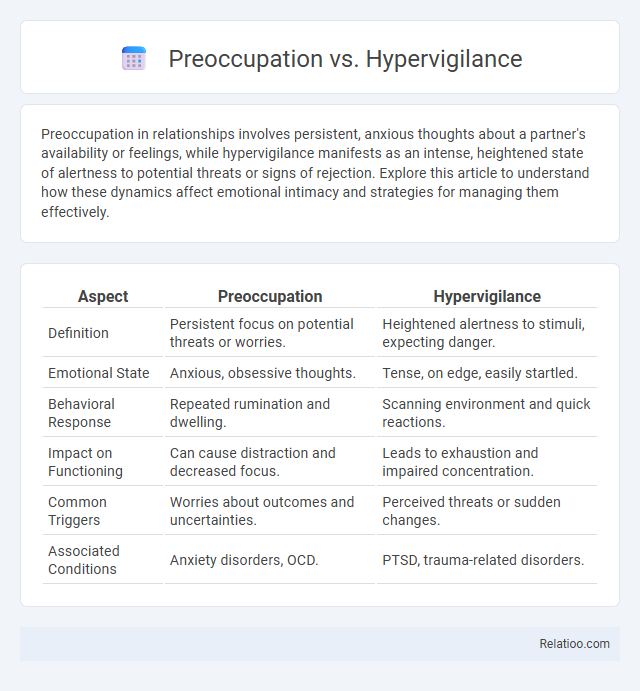Preoccupation in relationships involves persistent, anxious thoughts about a partner's availability or feelings, while hypervigilance manifests as an intense, heightened state of alertness to potential threats or signs of rejection. Explore this article to understand how these dynamics affect emotional intimacy and strategies for managing them effectively.
Table of Comparison
| Aspect | Preoccupation | Hypervigilance |
|---|---|---|
| Definition | Persistent focus on potential threats or worries. | Heightened alertness to stimuli, expecting danger. |
| Emotional State | Anxious, obsessive thoughts. | Tense, on edge, easily startled. |
| Behavioral Response | Repeated rumination and dwelling. | Scanning environment and quick reactions. |
| Impact on Functioning | Can cause distraction and decreased focus. | Leads to exhaustion and impaired concentration. |
| Common Triggers | Worries about outcomes and uncertainties. | Perceived threats or sudden changes. |
| Associated Conditions | Anxiety disorders, OCD. | PTSD, trauma-related disorders. |
Defining Preoccupation and Hypervigilance
Preoccupation refers to the state of being absorbed or engrossed in specific thoughts or concerns, often causing distraction from the current environment. Hypervigilance is characterized by an enhanced state of sensory sensitivity accompanied by an exaggerated intensity of behaviors aimed at detecting threats. Your awareness of these distinct psychological conditions can help in identifying symptoms and seeking appropriate interventions effectively.
Key Psychological Differences
Preoccupation involves persistent, intrusive thoughts centered on specific concerns, often causing mental distraction but not necessarily heightened sensory alertness. Hypervigilance is characterized by an amplified state of sensory sensitivity and an exaggerated scanning of the environment for potential threats, typically linked to anxiety disorders or PTSD. Compared to preoccupation, hypervigilance manifests more as an externalized, acute awareness of surroundings rather than internal cognitive fixation, marking distinct psychological processes between focus on internal worries and external threat detection.
Causes and Triggers of Preoccupation
Preoccupation often stems from underlying anxiety, unresolved stress, or trauma, serving as a mental fixation on specific concerns or fears. Hypervigilance entails an exaggerated state of sensory sensitivity and alertness, typically triggered by perceived threats, trauma, or post-traumatic stress disorder (PTSD). The causes and triggers of preoccupation commonly include persistent worry over personal relationships, work pressures, or health issues, which can fuel obsessive thought patterns and distract from present tasks.
Origins and Risk Factors of Hypervigilance
Hypervigilance originates from prolonged exposure to stress or trauma, causing heightened sensory sensitivity and constant alertness that can impair daily functioning. Risk factors include a history of PTSD, anxiety disorders, chronic stress, and traumatic events such as abuse or combat experiences. Understanding Your symptoms in context of these origins helps differentiate hypervigilance from general preoccupation or focused attention.
Emotional and Cognitive Manifestations
Preoccupation manifests as persistent, intrusive thoughts centered on specific concerns, often impairing emotional regulation and causing distraction. Hypervigilance heightens sensory sensitivity, creating a state of constant alertness that can provoke anxiety and cognitive overload. Your emotional well-being is impacted differently by each: preoccupation drains focus and amplifies worry, while hypervigilance triggers stress through exaggerated threat detection.
Impact on Daily Functioning
Preoccupation often leads to persistent thoughts that disrupt concentration, reducing productivity and impairing decision-making in daily tasks. Hypervigilance causes heightened alertness to potential threats, resulting in increased anxiety and exhaustion, which negatively affect social interactions and routine activities. While preoccupation primarily affects cognitive focus, hypervigilance impacts emotional regulation and physical energy, both significantly hindering overall daily functioning.
Associated Mental Health Conditions
Preoccupation often manifests in anxiety disorders, obsessive-compulsive disorder (OCD), and depression, where intrusive thoughts dominate cognitive processes. Hypervigilance is primarily linked to post-traumatic stress disorder (PTSD) and generalized anxiety disorder (GAD), characterized by an excessive state of sensory sensitivity and alertness to potential threats. While both involve heightened mental engagement, preoccupation is cognitive fixation on specific thoughts or worries, whereas hypervigilance entails an acute awareness of environmental stimuli, with distinct implications for diagnosis and treatment.
Diagnostic Criteria and Assessment
Preoccupation is characterized by persistent and intrusive thoughts linked to anxiety or obsessive concerns, often assessed using clinical interviews and standardized scales like the Yale-Brown Obsessive Compulsive Scale (Y-BOCS). Hypervigilance involves an enhanced state of sensory sensitivity and exaggerated threat detection, commonly evaluated through behavioral observation and tools such as the Clinician-Administered PTSD Scale (CAPS). Diagnostic criteria distinguish preoccupation by cognitive fixation, hypervigilance by heightened arousal and scanning for danger, and their assessment relies on symptom frequency, duration, and impact on daily functioning within DSM-5 or ICD-11 frameworks.
Coping Strategies and Interventions
Effective coping strategies for preoccupation involve mindfulness techniques and cognitive-behavioral therapy (CBT) to redirect obsessive thoughts and reduce mental fixation. Hypervigilance requires interventions such as grounding exercises and trauma-focused therapies like EMDR to manage heightened sensory sensitivity and reduce responses to perceived threats. Combining relaxation techniques, psychoeducation, and targeted therapy enhances overall emotional regulation and resilience in managing both preoccupation and hypervigilance.
Seeking Professional Help and Support
Preoccupation involves persistent focus on specific thoughts or concerns, while hypervigilance refers to an excessive state of alertness often linked to anxiety or trauma responses. Seeking professional help can provide targeted strategies to manage these mental states, improving your overall emotional well-being. Support from therapists or support groups can reinforce coping mechanisms, ensuring you maintain balance and reduce distress caused by intense mental focus or heightened awareness.

Infographic: Preoccupation vs Hypervigilance
 relatioo.com
relatioo.com